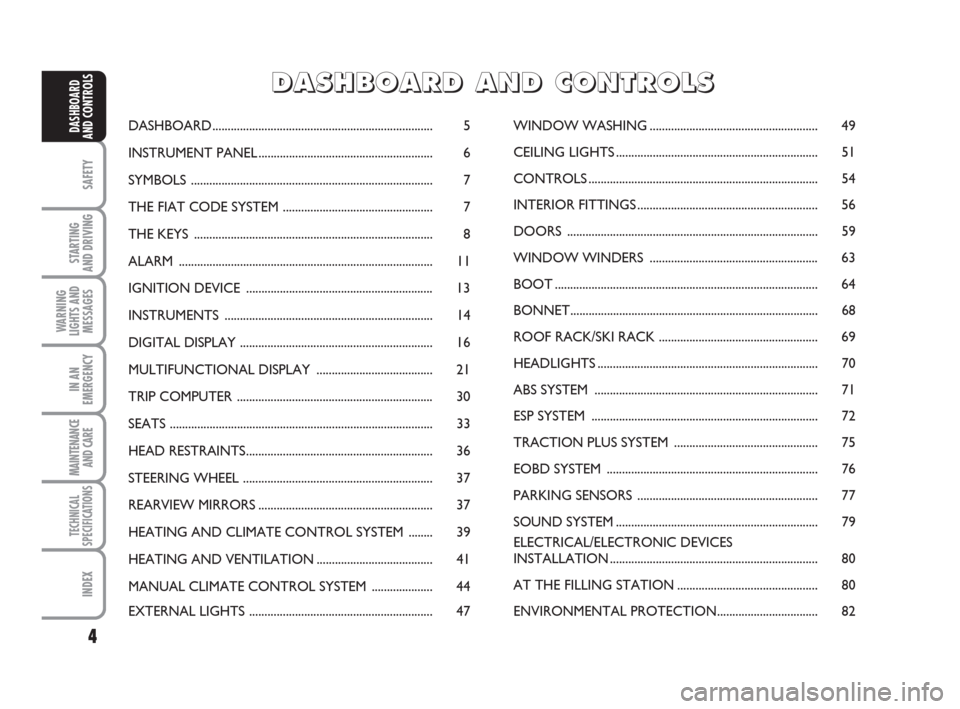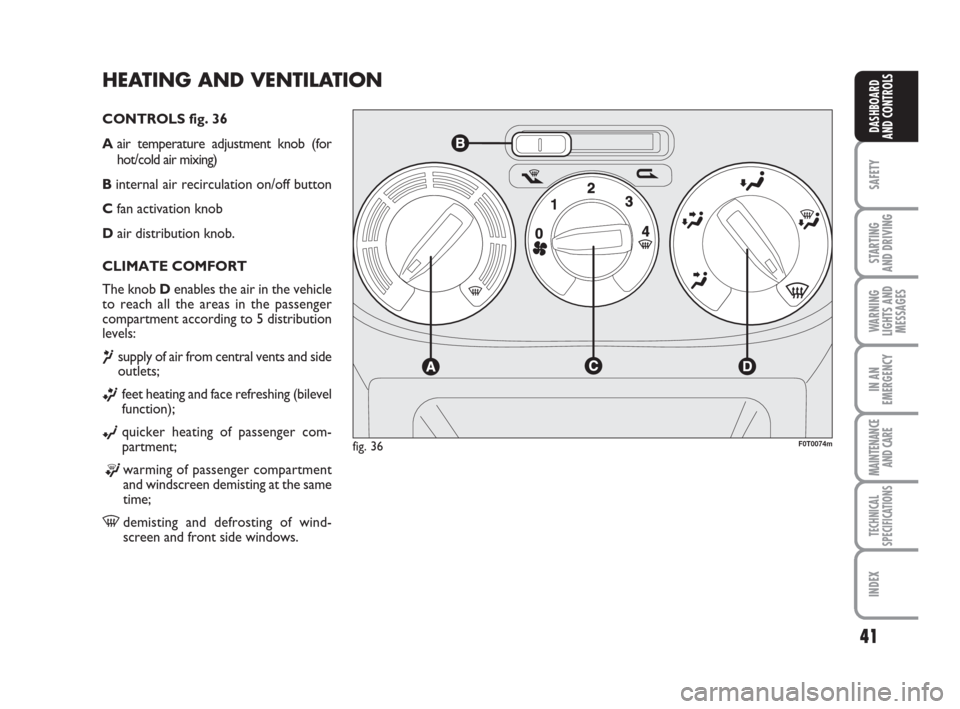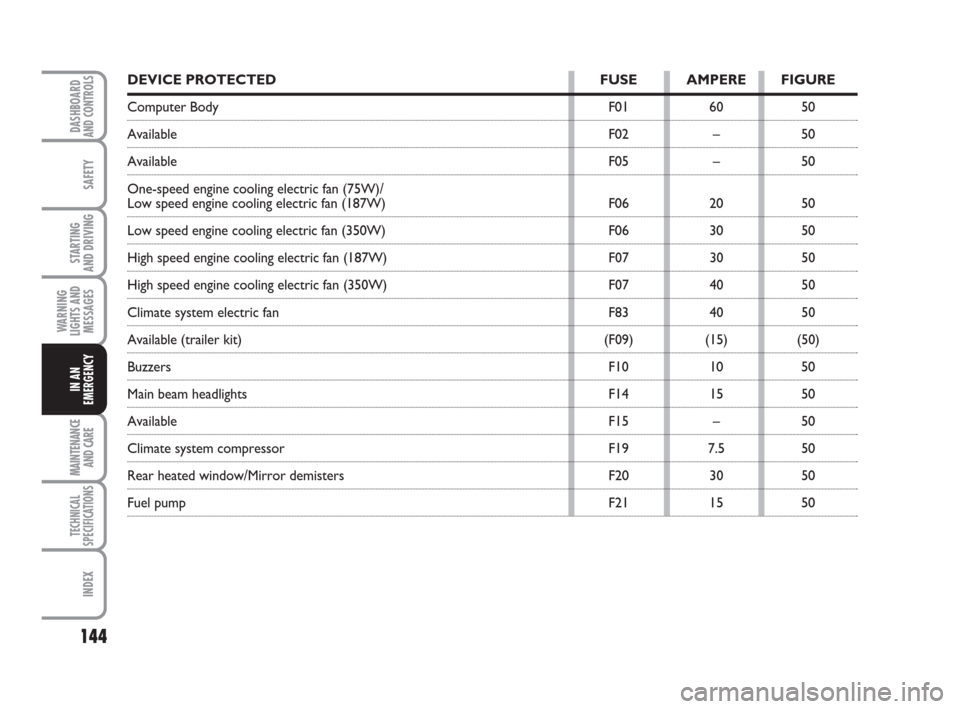climate control FIAT QUBO 2009 1.G Owners Manual
[x] Cancel search | Manufacturer: FIAT, Model Year: 2009, Model line: QUBO, Model: FIAT QUBO 2009 1.GPages: 202, PDF Size: 4.78 MB
Page 5 of 202

4
SAFETY
STARTING
AND DRIVING
WARNING
LIGHTS AND
MESSAGES
IN AN
EMERGENCY
MAINTENANCE
AND CARE
TECHNICAL
SPECIFICATIONS
INDEX
DASHBOARD
AND CONTROLSDASHBOARD........................................................................ 5
INSTRUMENT PANEL ......................................................... 6
SYMBOLS ............................................................................... 7
THE FIAT CODE SYSTEM ................................................. 7
THE KEYS .............................................................................. 8
ALARM ................................................................................... 11
IGNITION DEVICE ............................................................. 13
INSTRUMENTS .................................................................... 14
DIGITAL DISPLAY ............................................................... 16
MULTIFUNCTIONAL DISPLAY ...................................... 21
TRIP COMPUTER ................................................................ 30
SEATS ...................................................................................... 33
HEAD RESTRAINTS............................................................. 36
STEERING WHEEL .............................................................. 37
REARVIEW MIRRORS......................................................... 37
HEATING AND CLIMATE CONTROL SYSTEM ........ 39
HEATING AND VENTILATION ...................................... 41
MANUAL CLIMATE CONTROL SYSTEM .................... 44
EXTERNAL LIGHTS ............................................................ 47WINDOW WASHING....................................................... 49
CEILING LIGHTS.................................................................. 51
CONTROLS ........................................................................... 54
INTERIOR FITTINGS........................................................... 56
DOORS .................................................................................. 59
WINDOW WINDERS ....................................................... 63
BOOT ...................................................................................... 64
BONNET................................................................................. 68
ROOF RACK/SKI RACK .................................................... 69
HEADLIGHTS........................................................................ 70
ABS SYSTEM ......................................................................... 71
ESP SYSTEM .......................................................................... 72
TRACTION PLUS SYSTEM ............................................... 75
EOBD SYSTEM ..................................................................... 76
PARKING SENSORS ........................................................... 77
SOUND SYSTEM.................................................................. 79
ELECTRICAL/ELECTRONIC DEVICES
INSTALLATION.................................................................... 80
AT THE FILLING STATION.............................................. 80
ENVIRONMENTAL PROTECTION................................. 82
D D
A A
S S
H H
B B
O O
A A
R R
D D
A A
N N
D D
C C
O O
N N
T T
R R
O O
L L
S S
001-035 QUBO GB 1ed:001-035 Fiorino GB 1ed 3-12-2009 15:58 Pagina 4
Page 15 of 202

INSTRUMENTS
Instrument background colour and type
may vary according to the version.
TACHOMETER
(speed indicator) fig. 9
It shows the vehicle speed.REV. COUNTER fig. 10
The rev counter shows the engine rpm.
IMPORTANT The electronic injection con-
trol system gradually shuts off the flow of
fuel when the engine is “over-revving” re-
sulting in a gradual loss of engine power.
When the engine is idling, the rev counter
may indicate a gradual or sudden increase
of the speed. This is normal and does not
indicate a fault. It may be caused, for ex-
ample, by the operation of the climate
control system or fan. In this case, a slow
change in engine speed is used to protect
the battery charge.
fig. 9F0T0150mfig. 10F0T0151m
14
SAFETY
STARTING
AND DRIVING
WARNING
LIGHTS AND
MESSAGES
IN AN
EMERGENCY
MAINTENANCE
AND CARE
TECHNICAL
SPECIFICATIONS
INDEX
DASHBOARD
AND CONTROLS
001-035 QUBO GB 1ed:001-035 Fiorino GB 1ed 3-12-2009 15:58 Pagina 14
Page 40 of 202

39
SAFETY
STARTING
AND DRIVING
WARNING
LIGHTS AND
MESSAGES
IN AN
EMERGENCY
MAINTENANCE
AND CARE
TECHNICAL
SPECIFICATIONS
INDEX
DASHBOARD
AND CONTROLS
HEATING AND CLIMATE CONTROL SYSTEM
fig. 33F0T0148m
1.Upper fixed vent - 2.Adjustable central vents - 3.Fixed side vent - 4.Adjustable side vents - 5.Vents in feet area
036-082 QUBO GB 1ed:_ 3-12-2009 11:55 Pagina 39
Page 42 of 202

41
SAFETY
STARTING
AND DRIVING
WARNING
LIGHTS AND
MESSAGES
IN AN
EMERGENCY
MAINTENANCE
AND CARE
TECHNICAL
SPECIFICATIONS
INDEX
DASHBOARD
AND CONTROLS
HEATING AND VENTILATION
CONTROLS fig. 36
Aair temperature adjustment knob (for
hot/cold air mixing)
Binternal air recirculation on/off button
Cfan activation knob
Dair distribution knob.
CLIMATE COMFORT
The knob Denables the air in the vehicle
to reach all the areas in the passenger
compartment according to 5 distribution
levels:
¶supply of air from central vents and side
outlets;
ßfeet heating and face refreshing (bilevel
function);
©quicker heating of passenger com-
partment;
®warming of passenger compartment
and windscreen demisting at the same
time;
-demisting and defrosting of wind-
screen and front side windows.
fig. 36F0T0074m
036-082 QUBO GB 1ed:_ 3-12-2009 11:55 Pagina 41
Page 45 of 202

44
SAFETY
STARTING
AND DRIVING
WARNING
LIGHTS AND
MESSAGES
IN AN
EMERGENCY
MAINTENANCE
AND CARE
TECHNICAL
SPECIFICATIONS
INDEX
DASHBOARD
AND CONTROLS
MANUAL CLIMATE CONTROL SYSTEM (for versions/markets, where provided)
CLIMATE COMFORT
The knob Denables the air in the vehicle
to reach all the areas in the passenger
compartment according to 5 distribution
levels:
¶supply of air from central vents and side
outlets;
ßfeet heating and face refreshing (bilevel
function);
©quicker heating of passenger com-
partment;
®warming of passenger compartment
and windscreen demisting at the same
time;
-demisting and defrosting of wind-
screen and front side windows.
HEATING
Proceed as follows:
❒turn knob Aall the way to the right
(line on
-);
❒turn knob Cto the required speed;
❒turn knob Don:
®to warm the feet and at the same time
demist the windscreen;
ßto deliver air to the feet area and re-
lease cooler air from central vents
and outlets on the dashboard;
©to heat the area quickly. CONTROLS fig. 38
Aair temperature adjustment knob (for
hot/cold air mixing);
Binternal air recirculation on/off button;Cfan and climate control system activa-
tion/deactivation knob;
Dair distribution knob.
fig. 38F0T0029m
036-082 QUBO GB 1ed:_ 3-12-2009 11:55 Pagina 44
Page 46 of 202

45
SAFETY
STARTING
AND DRIVING
WARNING
LIGHTS AND
MESSAGES
IN AN
EMERGENCY
MAINTENANCE
AND CARE
TECHNICAL
SPECIFICATIONS
INDEX
DASHBOARD
AND CONTROLS
FAST HEATING
Proceed as follows:
❒close all the vents on the dashboard;
❒turn knob Aon
-;
❒turn knob Con 4
-;
❒turn knob Don
ß.
FAST DEMISTING/
DEFROSTING OF WINDSCREEN
AND FRONT SIDE WINDOWS
(MAX-DEF function)
Proceed as follows:
❒turn knob Aon
-;
❒turn knob Con 4
-;
❒turn knob Don
-;
❒turn cursor Bon
¶.
After demisting/defrosting, operate the
standard controls to restore the required
comfort conditions.
IMPORTANT The climate control system
is very useful for faster demisting because
it dries the air. Regulate the controls as
described above and engage the climate
control by pressing knob C.Window demisting
In the event of considerable external mois-
ture and/or rain and/or considerable dif-
ferences in temperature inside and out-
side the passenger compartment, perform
the following preventive demisting proce-
dure:
❒turn cursor Bon
¶;
❒turn knob Aon
-;
❒turn knob Con 2;
❒turn knob Don
-having the possi-
bility to reach position
®if the win-
dows are not misty.
REGULATING THE FAN SPEED
To ventilate the passenger compartment
properly proceed as follows:
❒fully open the central air vents and side
outlets;
❒turn knob Ato the blue section;
❒turn cursor Bon
¶;
❒turn knob Cto the required speed;
❒turn knob Don
©.ACTIVATION OF
INTERNAL AIR
RECIRCULATION
Turn cursor Bto position
v.
It is advisable to activate air recirculation
during vehicle stops in queues or tunnels
to prevent the introduction of polluted air
from the outside.
Do not use the function for a long time,
particularly if there are many passengers
on board, to prevent the windows from
misting up.
IMPORTANT The internal air recircula-
tion system makes it possible to reach the
required “heating” or “cooling” condi-
tions faster. Do not use the air recircula-
tion function on rainy/cold days as it would
considerably increase the possibility of the
windows misting inside.
036-082 QUBO GB 1ed:_ 3-12-2009 11:55 Pagina 45
Page 47 of 202

46
SAFETY
STARTING
AND DRIVING
WARNING
LIGHTS AND
MESSAGES
IN AN
EMERGENCY
MAINTENANCE
AND CARE
TECHNICAL
SPECIFICATIONS
INDEX
DASHBOARD
AND CONTROLS
SERVICING THE SYSTEM
Let the climate control system run for at
least 10 minutes every month during the
winter. Have the system inspected at a Fi-
at Dealership before the summer. CLIMATE CONTROL (cooling)
Proceed as follows:
❒turn knob Ato the blue section;
❒turn knob Con 4
-;
❒turn cursor Bon
v;
❒turn knob Don
©;
❒turn knob C.
Regulating cooling
Proceed as follows:
❒turn cursor Bon
¶;
❒turn knob Ato the right to increase the
temperature;
❒turn knob Cto the left to reduce the
fan speed.DEMISTING/DEFROSTING
OF REAR HEATED WINDOW
AND DOOR MIRRORS
fig. 39
(for versions/markets, where provided)
Press button (to engage this function.
When the function is active, a led on the
button goes on.
To disable this function, press the button
(again.
IMPORTANT Do not apply stickers on
the inside of the rear window over the
heating filaments to avoid damage that
might cause it to stop working properly.
fig. 39F0T0048m
036-082 QUBO GB 1ed:_ 3-12-2009 11:55 Pagina 46
Page 107 of 202

106
SAFETY
WARNING
LIGHTS AND
MESSAGES
IN AN
EMERGENCY
MAINTENANCE
AND CARE
TECHNICAL
SPECIFICATIONS
INDEX
DASHBOARDAND CONTROLS
STARTING
AND DRIVING
Roof rack/ski rack
Remove the roof rack or the ski rack from
the roof after use. These accessories de-
crease aerodynamic penetration of the ve-
hicle and have a negative effect on fuel
consumption. It is better to use a trailer
to transport particularly bulky objects.
Electric devices
Use electric devices only for the amount
of time needed. The rear heated window,
additional headlights, windscreen wipers
and heater fan need a considerable
amount of energy, therefore increasing fu-
el consumption (up to +25% in the urban
cycle).
Climate control
The climate control system leads to high-
er fuel consumption (up to +20% on av-
erage): use air vents only when the ex-
ternal temperature allows it.
Spoilers
The use of non-certified spoilers may ad-
versely affect air drag and fuel consump-
tion levels.DRIVING STYLE
Starting
Do not warm the engine up with the ve-
hicle running at min. or max. rpm: the en-
gine warms up very slowly in these con-
ditions, increasing consumption and emis-
sions. It is advisable to start off immedi-
ately and slowly keeping the engine speed
down: the engine will warm up much
faster this way.
Unnecessary manoeuvres
Avoid revving up when starting at traffic
lights or before stopping the engine. The
latter manoeuvre, like doubling the clutch,
is unnecessary and causes increased fuel
consumption and pollution.
Gear selection
Use a higher gear as soon as traffic and road
conditions allow. Using a low gear for faster
acceleration will increase consumption.
In the same way improper use of a high gear
increases fuel consumption, emissions and
engine wear.
Top speed
Fuel consumption considerably increases as
speed increases. Keep your speed as uni-
form as possible, avoiding unnecessary
braking and acceleration which cause ex-
cessive fuel consumption and increase emis-
sions.Acceleration
Sudden acceleration has a very negative
effect on consumptions and emissions: ac-
celerate gradually.
CONDITIONS OF USE
Cold starting
Short distances and frequent cold start-
ups will prevent the engine from reach-
ing optimal running temperature.
Consequently, both consumption (from
+15 to +30% on urban cycle ) and emis-
sions will increase.
Traffic and road conditions
Quite high consumption is caused by
heavy traffic, for instance when travelling
in a queue with frequent use of low gears
or in cities with many traffic lights. Moun-
tain and rough roads also have a negative
effect on consumption.
Traffic hold-ups
During prolonged hold-ups (e.g. level cross-
ings) the engine should be switched off.
101-108 QUBO GB 1ed:101-110 Fiorino GB 1ed 2-12-2009 9:22 Pagina 106
Page 145 of 202

144
SAFETY
MAINTENANCE
AND CARE
TECHNICAL
SPECIFICATIONS
INDEX
DASHBOARDAND CONTROLS
STARTING
AND DRIVING
WARNING
LIGHTS AND
MESSAGES
IN AN
EMERGENCY
DEVICE PROTECTED FUSE AMPERE FIGURE
Computer Body F01 60 50
Available F02 – 50
Available F05 – 50
One-speed engine cooling electric fan (75W)/
Low speed engine cooling electric fan (187W) F06 20 50
Low speed engine cooling electric fan (350W) F06 30 50
High speed engine cooling electric fan (187W) F07 30 50
High speed engine cooling electric fan (350W) F07 40 50
Climate system electric fan F83 40 50
Available (trailer kit) (F09) (15) (50)
Buzzers F10 10 50
Main beam headlights F14 15 50
Available F15 – 50
Climate system compressor F19 7.5 50
Rear heated window/Mirror demisters F20 30 50
Fuel pump F21 15 50
119-150 QUBO GB 1ed:123-154 Fiorino GB 1ed 3-12-2009 16:00 Pagina 144
Page 170 of 202

169
SAFETY
TECHNICAL
SPECIFICATIONS
INDEX
DASHBOARDAND CONTROLS
STARTING
AND DRIVING
WARNING
LIGHTS AND
MESSAGES
IN AN
EMERGENCY
MAINTENANCE
AND CARE
BODYWORK
PROTECTION FROM
WEATHER CONDITIONS
The main causes of corrosion are the fol-
lowing:
❒atmospheric pollution;
❒salty air and humidity (coastal areas or
hot humid climates);
❒seasonal environment conditions.
Equal importance must be attributed to
the abrasive action of wind-borne atmos-
pheric dust as well as sand and mud and
gravel raised by other vehicles.
On your vehicle Fiat has adopted the best
manufacturing technologies to effectively
protect the bodywork against corrosion.These are the most important technolo-
gies:
❒painting products and systems which
give the vehicle particular resistance to
corrosion and abrasion;
❒use of galvanised (or pre-treated) steel
sheets with high resistance to corro-
sion;
❒spraying the underbody, engine com-
partment, wheelhouse internal parts
and other parts with highly protective
wax products;
❒spraying of plastic parts with a protec-
tive function in the more exposed
points: underdoor, inner fender parts,
edges, etc.;
❒use of “open” boxed sections to pre-
vent condensation and pockets of mois-
ture from triggering rust inside.VEHICLE BODY
AND UNDERBODY WARRANTY
Your vehicle is covered by warranty
against perforation due to rust of any orig-
inal element of the structure or body.
For the general terms of this warranty, re-
fer to the Fiat Warranty Booklet.
151-172 QUBO GB 1ed:- 3-12-2009 12:01 Pagina 169